Thresholds of No Return
Travel & Adventure Reviewed in March/April
“There are thresholds we cross that leave us profoundly, irrevocably changed,” writes Michael Engelhard in American Wild, and whether those thresholds lead to beauty and grandeur, solitude and deep silence, or to encounters of the more hair-raising kind, the outdoor enthusiasts, wildlife biologists, and intrepid travelers whose books are featured here all agree: travel is transformative. While some adventures may terrify—a grizzly bear attack, or scouting out places so dangerous that visiting is only allowed with police escort—others lead to ineffable beauty and friendships that last a lifetime. Either way, once these thresholds have been crossed, there’s no going back.
Tracking Gobi Grizzlies
Surviving Beyond the Back of Beyond
![]()
Douglas H. Chadwick
Patagonia
Hardcover $24.95 (288pp)
978-1-938340-62-8
Buy: Local Bookstore (Bookshop)
“In a remote and pitiless desert on the other side of the world from North America lives a bear that science understands only poorly so far and the general public isn’t aware of at all,” writes wildlife biologist Douglas Chadwick. “One of the scarcest creatures on the planet, it is a type of grizzly so extraordinary that its existence is hard to imagine even after you get to its homeland; in fact, especially after you get to its homeland.”
The Great Gobi Desert, one of the five largest deserts on the earth, covers half a million square miles, and with rainfall averaging a mere four to six inches per year and temperatures that soar to 122 degrees Fahrenheit in summer and drop to as low as minus forty in winter, it is not the most comfortable place to track, capture, and radio-collar grizzlies. But time is of the essence if this unique subspecies is to be saved; Gobi grizzlies are now the rarest bears in the world, with only three to four dozen remaining. For a month every spring since 2005, the Gobi Bear Project team has been catching and radio-collaring these grizzlies.
Though Chadwick and the other members of the Gobi Bear Project know that saving these big, unruly, long-eared, shaggy, fun-loving, chocolate-colored, bronze, or golden Gobi grizzly bears will not change the world, it will at least keep them in it. That alone would make their work worthwhile, not to mention wild motorcycle rides through the astounding stony landscape and the thrill of discovering a bear in one of their traps.
“Here’s the deal with most of us grown-up naturalists,” Chadwick writes. “While we can toss around Latin names and biological principles, there’s a huge part of us that’s still just an eleven-year-old on a treasure hunt.”
KRISTINE MORRIS (March 7, 2017)
Songs of the Baka and Other Discoveries
Travels after Sixty-Five

Dennis James
Barbara Grossman, photographer
Skyhorse Publishing
Hardcover $24.99 (240pp)
978-1-5107-1350-5
Buy: Local Bookstore (Bookshop)
Friends and family warned them of malaria, dengue fever, and cannibals, but for retired lawyers Dennis James and his wife, Barbara, the lure of learning from indigenous people who still live much as humans had twelve thousand years ago, of visiting countries the US State Department warns against, and of trekking through pristine, rarely visited landscapes was too strong to resist. Their goal: to learn how different cultures, some of them centuries old, manage to survive, resist change, and be happy; and to discover what Westerners might learn from them.
They were warmly welcomed by tribes in Papua New Guinea, farmers in Ethiopia, the cliff-dwelling Dogon in Mali, and the hunter-gatherer Baka Pygmies of Cameroon. They visited Algerian cities ruled by men—where married women were one-eyed wraiths swathed in white—and trekked with Sherpas in Nepal. They stayed in places with no toilets or showers, experienced “acrophobia morphing into vertigo” while navigating narrow ledges along steep volcanic cliffs, and dealt with injuries and health issues. They reveled in Cuba’s thriving arts scene, visited an Iranian Zoroastrian temple in which a flame has been burning since 470 AD, and experienced how cold numbers cannot convey the depth of people’s suffering in Gaza. In some of the most primitive spots, they found beautiful, clean communities where, despite the lack of material things, no one ever went hungry or uncared for. Everywhere, they found friendly, kind, hospitable people. They also learned how fragile some of these communities are and how vulnerable they are to climate change and the incursion of Western culture.
They returned “irrevocably changed,” with a wealth of stories and beautiful photos to share, and deeply aware that no matter how different people seem, they all want the same things: peace, adequate food and shelter, and a good life for their children.
KRISTINE MORRIS (March 7, 2017)
Patagonian Road
A Year Alone Through Latin America
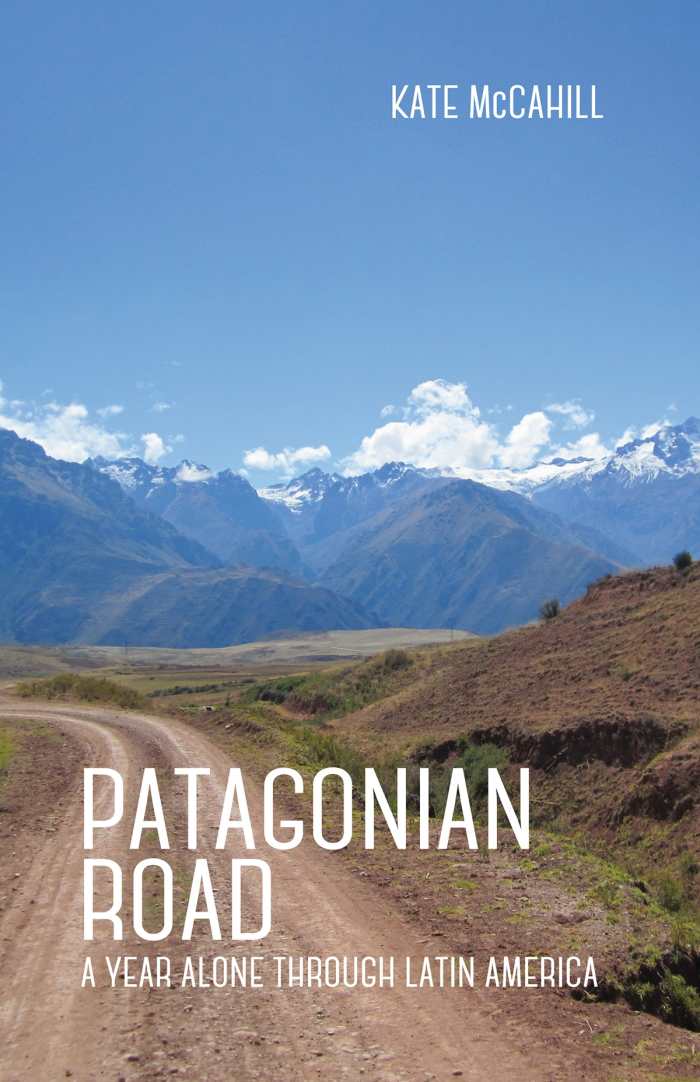
Kate McCahill
Santa Fe Writer’s Project
Softcover $16.95 (350pp)
978-1-939650-54-2
Buy: Local Bookstore (Bookshop)
“When I began my journey, I anticipated danger at every turn,” writes Kate McCahill, whose rugged solo trip, mostly by bus, took her through ten Latin American countries.
When she started out, following Paul Theroux’s 1979 route in his travelogue The Old Patagonian Express, McCahill knew very little about Latin America, and even less about the privileges she took for granted as a white, twenty-first-century American woman. “How naïve I was as I fumbled through Latin America; how stupid I was at times, and how lucky,” she writes, noting that she had vastly underestimated the power of the road to both challenge and heal. She found her ties to home, even to her lover whom she’d left behind, loosening the farther she traveled. She became greedy for “the constant shift, the mystery every new place holds, the plunge again into anonymity.”
McCahill writes as much about the inner changes wrought by travel as she does about the landscapes and people of the places she visited. Bypassing most tourist spots, her eyes were opened to the privilege she had known and to events of which she’d been unaware; everyday people told the shocking truth about the effects of US intervention in Central and South America, of disapproved-of governments toppled, of fear, of loved ones “disappeared”; she met fellow travelers who were often more exotic than the locals, and she saw poverty that stopped her breath. But she also found welcome, beauty, the joy of discovering kindred spirits among strangers, and how travel, with its disorienting newness, makes every moment an opportunity for transformation.
This is poetic writing, spare and deep, that unashamedly plumbs the depths of the solitary heart as it is pried open to learn that “it is in feasting on the unknown that we come to know ourselves.”
KRISTINE MORRIS (March 7, 2017)
American Wild
Explorations from the Grand Canyon to the Arctic Ocean
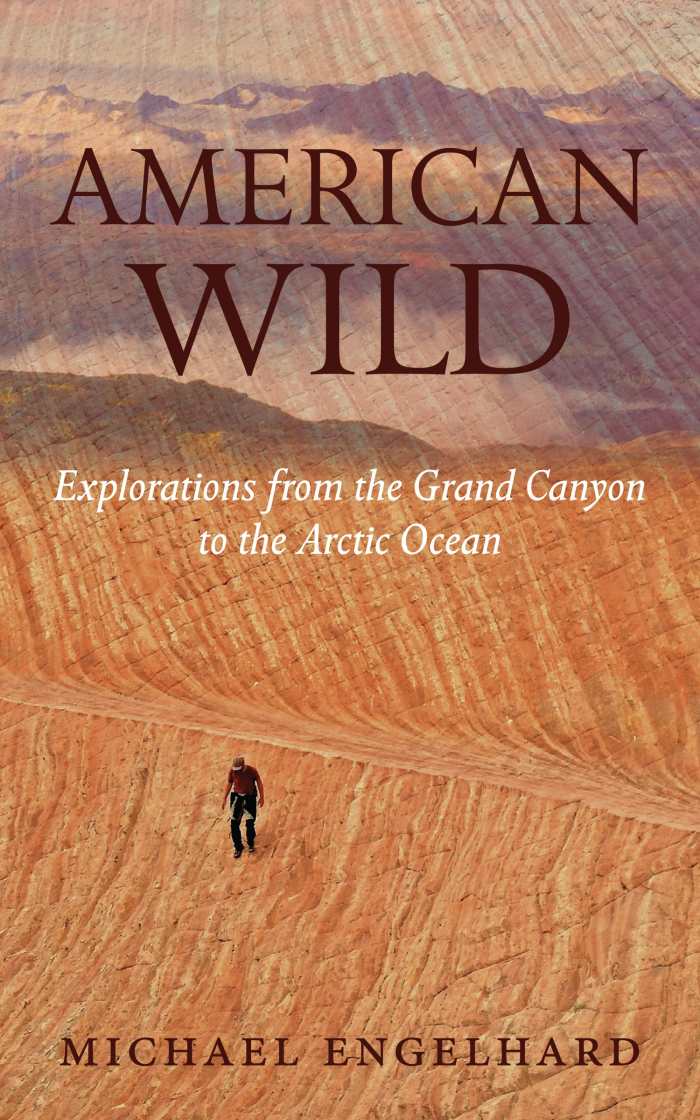
Michael Engelhard
Hiraeth Press
Softcover $17.95
978-0-9889430-9-4
“Call me a bigamist, if you like,” writes Michael Engelhard, a wildlife biologist and consummate storyteller whose passion for two vastly different American landscapes, separated by twenty-five hundred miles, has made him kin to those migratory creatures whose needs demand an equally peripatetic existence.
Engelhard, who calls himself “a vagrant by inclination and training” and a Luddite who neither drives nor owns a phone, is in love with the high desert of the Four Corners and the Colorado Plateau; with the American far north, Alaska, and the Arctic Refuge. He is addicted to landscapes defined by absences, to places that “streams, snow geese and caribou cross without passports”: “Long sightlines, the lack of dense forests or human populations, both in the Arctic and the Southwest set my heartstrings to humming,” he writes.
Honest to a fault, Engelhard doesn’t romanticize his experience of hiking Glen Canyon: “Blackbrush, locust, agaves, and carnivorous limestone gouged my forearms and shins,” he writes. “My knees and lower back ached, embedded spines festered, and the pack’s hip-belt left plum-colored bruises.” Yet he also writes of how the days could shine “robin’s egg blue, shimmering uniformly, like pearls on a string,” and of the delight he took in a “custard-colored scorpion.” He reevaluates his place in the food chain when attacked by fierce and prolific Alaskan mosquitoes and writes of two days in a tent, “whopped by wind like a helicopter”; of the “Iditabike,” a two-hundred-mile race requiring pepper spray to ward off wolves; of the joy of paddling a solitary kayak through nature’s deep silence; and of “light dense and golden as mead.”
Thoroughly at home in these wild places and among their creatures, Engelhard is a worthy guide across thresholds that can provoke profound, irrevocable change.
KRISTINE MORRIS (January 25, 2017)
Yellowstone National Park
Through the Lens of Time
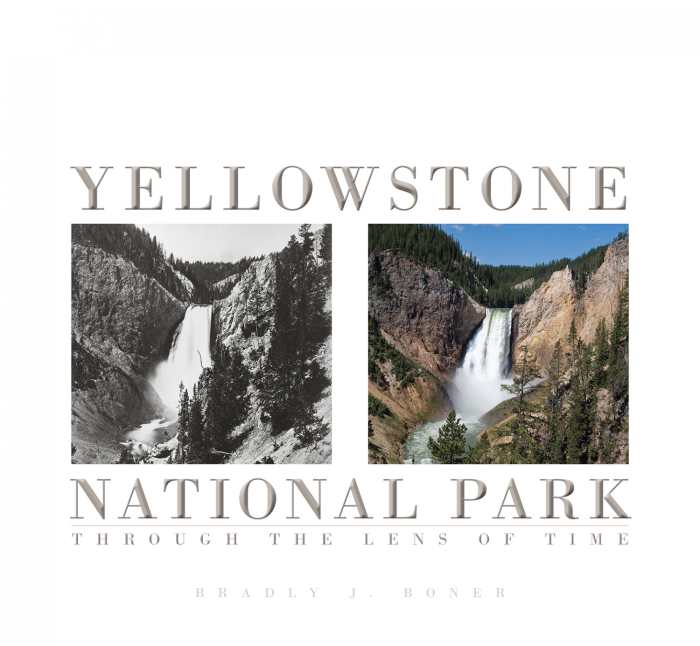
Bradly J. Boner
University Press of Colorado
Hardcover $39.95 (368pp)
978-1-60732-448-5
Photojournalist Bradly Boner, who has spent almost two decades documenting some of the most culturally rich corners of the American landscape, first felt the power of Yellowstone at the age of ten, on a family trip that was to mark him forever. Yellowstone National Park: Through the Lens of Time is his visual tribute to the place and to the work of pioneering photographer William Henry Jackson, who, as part of the 1871 Hayden Survey, first captured its grandeur. Aware of the awe and wonder Jackson must have felt as he beheld Yellowstone for the first time, Boner did meticulous research on his photos, and then, to arrive at Jackson’s exact locations, confronted the hazards of inclement weather, the proximity of wildfires, possible confrontations with wild animals, the risk of getting lost, and waist-deep river crossings. He then retook Jackson’s black-and-white shots in breathtaking color and laid the images side by side in a gorgeous visual celebration of nature’s wild, pristine glory.
Early reports of the wonders of this wilderness were thought to be the mad ramblings of men who had spent too much time alone in the wild. It was the work of artists like Thomas Moran and photographers like Jackson that captured the imagination of the nation and inspired the creation of the world’s first national park at Yellowstone.
Now, Boner’s luscious photographs, enhanced with personal stories and information on the area’s history and geology, are available to make visiting the park a richer, more memorable experience; but even those whose travels are of the imaginary sort will be awed and enchanted by his stunning record of nature’s mighty cataclysms and the wild beauty that has been left in our keeping.
KRISTINE MORRIS (March 7, 2017)
Zero Degrees
Geographies of the Prime Meridian
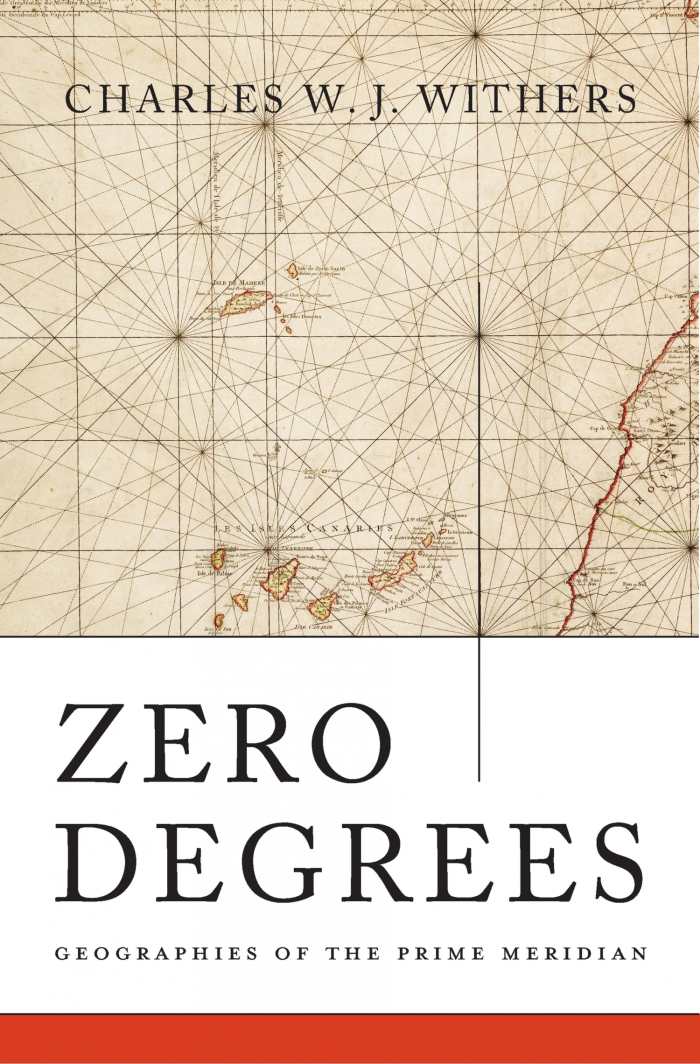
Charles W. J. Withers
Harvard University Press
Hardcover $29.95 (348pp)
978-0-674-08881-8
Buy: Local Bookstore (Bookshop)
The prime meridian, though not a “real thing,” rules the life of everyone on the planet; it’s the place at which the world’s longitude is set at zero degrees, giving humans the ability to standardize the measures of both longitude and time. Since 1884, the prime meridian has been fixed at the Royal Observatory, in Greenwich, United Kingdom, though improved measurement technology has since adjusted it a little to the east of its original location. But imagine a time, not too long ago, when there were more than twenty prime meridians, with nations often using their own capitals to designate the zero-degree point, causing great confusion for explorers, navigators, astronomers, and others.
Professor Charles Withers, who is Ogilvie Chair of Geography at the University of Edinburgh, discusses the challenges and dangers of attempting to navigate a world with multiple prime meridians as increased globalization and advances in transportation made the seas busier and brought nations closer together. Withers reveals how, even though all could see the danger and confusion caused by reliance on multiple meridians, unravelling centuries of national practices and prejudices to arrive at agreement on a single location proved difficult, partly because it threatened to raise the importance of science over that of politics.
In 1884, after other attempts to arrive at agreement had failed, geographers, astronomers, navigators, and politicians from over twenty countries convened an International Meridian Conference in Washington, DC, to propose a single prime meridian “for the good of the world.” This was the first such conference at which delegates could cast their votes on behalf of nations.
Today’s travelers and scientists owe much to the fact that, despite difficulties (including an attempted bombing), the 1884 International Meridian Conference agreed upon and established a single prime meridian to make the world a safer, more easily measurable place.
KRISTINE MORRIS (March 7, 2017)
One Last Cast
Reflections of an Outdoor Life
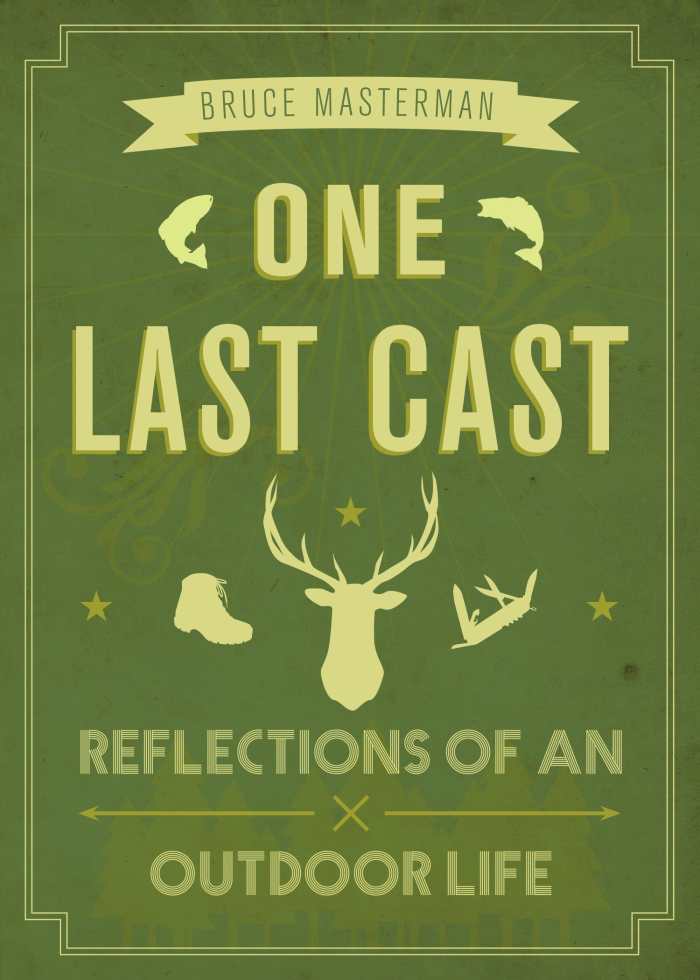
Bruce Masterman
Rocky Mountain Books
Softcover $20.00 (240pp)
978-1-77160-214-3
Buy: Local Bookstore (Bookshop)
In One Last Cast, award-winning Canadian journalist and nonfiction writer Bruce Masterman brings together thirty-six stories, intimate reflections on nature and its critters, written over his career of forty-plus years. A passionate outdoorsman for whom fishing, hunting, camping, hiking, snowshoeing, and quietly observing the cycle of the seasons is a way of life, Masterman is also a convivial storyteller who brings the wonders of nature both to those already primed for adventure and to those who prefer to view it from the comfort of an armchair.
Masterman first brings the eye of a naturalist, the heart of a poet, and a journalist’s curiosity to his descriptions of the rhythm of the seasons in a marsh: spring, when everything bursts into life as its colorful cast arrives to stake out space for nesting sites; summer, with its work of preparing the young for survival and the coming migration; autumn’s glowing colors and hunting shrouded in fog and mist; and winter, when waves have been stilled and dusted in white and his dog dashes about on the frozen water where she once swam. Together, his stories weave a rich and warmly colored tapestry of memories of landscape, place, people, and creatures both domestic and wild.
Masterman’s stories are personal but reach into the universal in their treatment of life’s joys, sorrows, wins, and losses, from the reminder to really live and confront challenges that was brought to him by death of two friends, to the especially tender story of how times spent fly fishing with his daughter grew into warm memories that bless them both now that she is grown.
Like naturalist John Muir before him, Masterman has found that a good life demands beauty as well as bread, and he has found in nature the source of both.
KRISTINE MORRIS (March 7, 2017)
Taleisin’s Tales
Sailing towards the Southern Cross

Lin Pardey
Larry Pardey
L & L Pardey Publications
Softcover $18.95 (220pp)
978-1-929214-11-2
Buy: Local Bookstore (Bookshop)
Their first voyage, on the 24’4“ Seraffyn, took them on an eastward course around the world, but avid cruisers, boatbuilders, and award-winning writers Lin and Larry Pardey had never ventured south of the Equator. They wondered if, years after that first journey, they would feel the same sense of adventure and wonder and still find welcome from islanders. Could they still dive into the sea “clad only in sun-tan lotion” despite more crowded seas?
Their adventure on board the larger, and also self-built, Taleisin was marked by freedom, a kind of madness, and immeasurable joy. They sailed from California to the Sea of Cortez, across the Pacific to French Polynesia, the Cook Islands and Tonga, and on to New Zealand, reveling in their teamwork on board, their encounters with fellow cruisers, and in meeting locals along the way. In a dusty Mexican village, a woman gifted Lin with her only treasure: every bloom from her exuberant garden; Polynesian, Tongan, and Pitcairn islanders offered community feasts and introduced them to a way of life in which no one went hungry, was left an orphan, or sent to an old age home. There were near misses with whales and fishermen, battles with stormy seas, and white-knuckle passages to find safe harbor. They found adventure, welcome, and wonder, but also change: indigenous people were demanding recognition, were concerned for the environment, and were aware of the problems they faced as small island nations.
Taleisin’s Tales, along with stories of high adventure and peaceful nights under star-filled skies, also has enough technical sailing talk to inform and inspire fellow cruisers. Best of all, it’s the story of two people in love with the sea and with each other, who, sailing a relatively small, engineless boat, created bonds of love and friendship that circle the globe.
KRISTINE MORRIS (March 7, 2017)
Kristine Morris

